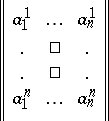Symmetrization (of tensors)
One of the operations in tensor algebra that constructs a symmetric tensor (relative to a group of indices) from a given tensor. Symmetrization always takes place over several upper or lower indices. A tensor  with components
with components  is the result of symmetrization of a tensor
is the result of symmetrization of a tensor  with components
with components  relative to
relative to  upper indices, for example relative to the group of indices
upper indices, for example relative to the group of indices  , if
, if
 | (*) |
Here the summation is taken over all  permutations
permutations  of
of  . Symmetrization relative to a group of lower indices is defined similarly. Symmetrization with respect to a group of indices is defined by placing these indices between round brackets
. Symmetrization relative to a group of lower indices is defined similarly. Symmetrization with respect to a group of indices is defined by placing these indices between round brackets  . The fixed indices (those not used in the symmetrization) are distinguished by vertical lines. For example (symmetrization over
. The fixed indices (those not used in the symmetrization) are distinguished by vertical lines. For example (symmetrization over  ;
;  remains fixed),
remains fixed),
 |
Successive symmetrization relative to groups  and
and  ,
,  , coincides with symmetrization relative to
, coincides with symmetrization relative to  . In other words, if
. In other words, if  , then
, then  (inner brackets are removed).
(inner brackets are removed).
A tensor which does not change on symmetrization with respect to some group of indices is called a symmetric tensor.
Symmetrization, with respect to some group, of a tensor which was alternated first (see Alternation) with respect to that group, leads to the zero tensor.
The multiplication of two or more tensors, followed by symmetrization of the product relative to all indices, is called symmetric multiplication. Symmetrization of tensors, side by side with the alternation operation, is used for the decomposition of a tensor into tensors with a simpler structure. Symmetrization is also used for the formation of sums of the form (*) with multi-indexed terms. For example, if the elements of the matrix
 |
commute under multiplication, then the expression
 |
is called the permanent of the matrix.
References
| [1] | P.A. Shirokov, "Tensor calculus. Tensor algebra" , Kazan' (1961) (In Russian) |
| [2] | D.V. Beklemishev, "A course of analytical geometry and linear algebra" , Moscow (1971) (In Russian) |
| [3] | J.A. Schouten, "Tensor analysis for physicists" , Cambridge Univ. Press (1951) |
Comments
Cf. also the editorial comments to Symmetrization.
References
| [a1] | M.A. Akivis, V.V. Goldberg, "An introduction to linear algebra & tensors" , Dover, reprint (1977) (Translated from Russian) |
| [a2] | M. Marcus, "Finite dimensional multilinear algebra" , 1 , M. Dekker (1973) pp. 77ff |
Symmetrization (of tensors). Encyclopedia of Mathematics. URL: http://encyclopediaofmath.org/index.php?title=Symmetrization_(of_tensors)&oldid=17148